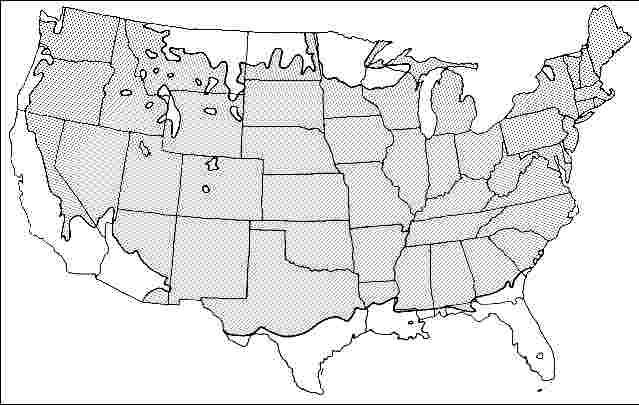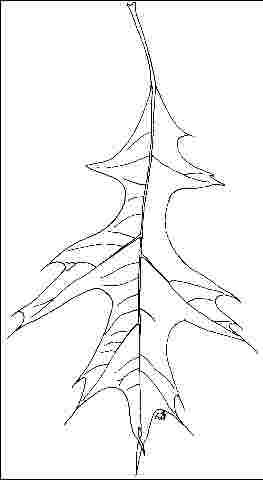Quercus palustris: Pin Oak1
Introduction
Pin oak is one of the most utilized (perhaps overused) oaks in the midwest and eastern United States. Popular due to the attractive pyramidal shape and straight, dominant trunk, even on older specimens, it exhibits chlorosis on high pH and limestone soils because of iron-deficiency and so is not highly recommended for these sites. Green, glossy leaves borne on relatively small-diameter branches give way to brilliant red to bronze fall color attracting attention in the landscape. Some brown leaves persist on the tree into the winter providing interest to some people. Others do not care to use pin oak because of the leaf persistence characteristic.

Credit: Ed Gilman, UF/IFAS
General Information
Scientific name: Quercus palustris
Pronunciation: KWERK-us pal-US-triss
Common name(s): Pin oak
Family: Fagaceae
USDA hardiness zones: 4A through 8A (Fig. 2)
Origin: native to North America
Invasive potential: little invasive potential
Uses: reclamation; street without sidewalk; specimen; screen; parking lot island 100-200 sq ft; parking lot island > 200 sq ft; sidewalk cutout (tree pit); tree lawn 4-6 feet wide; tree lawn > 6 ft wide; urban tolerant; highway median; shade
Availability: not native to North America

Description
Height: 50 to 75 feet
Spread: 35 to 40 feet
Crown uniformity: symmetrical
Crown shape: pyramidal
Crown density: moderate
Growth rate: moderate
Texture: medium
Foliage
Leaf arrangement: alternate (Fig. 3)
Leaf type: simple
Leaf margin: lobed, parted
Leaf shape: deltoid, ovate, oblong, obovate
Leaf venation: pinnate
Leaf type and persistence: deciduous
Leaf blade length: 2 to 4 inches, 4 to 8 inches
Leaf color: green
Fall color: red, copper
Fall characteristic: showy

Flower
Flower color: brown
Flower characteristics: not showy
Fruit
Fruit shape: oval, round
Fruit length: less than .5 inch, .5 to 1 inch
Fruit covering: dry or hard
Fruit color: brown
Fruit characteristics: attracts squirrels/mammals; not showy; fruit/leaves a litter problem
Trunk and Branches
Trunk/bark/branches: branches droop; not showy; typically one trunk; thorns
Pruning requirement: little required
Breakage: susceptible to breakage
Current year twig color: green, brown
Current year twig thickness: thin
Wood specific gravity: 0.63
Culture
Light requirement: full sun
Soil tolerances: clay; sand; loam; acidic; extended flooding; well-drained
Drought tolerance: moderate
Aerosol salt tolerance: low
Other
Roots: not a problem
Winter interest: yes
Outstanding tree: no
Ozone sensitivity: sensitive
Verticillium wilt susceptibility: resistant
Pest resistance: resistant to pests/diseases
Use and Management
When grown on an acid soil, this can be a handsome specimen tree. The lower branches tend to droop, middle branches are horizontal and branches in the upper part of the crown grow upright. Lower branches will require removal when used as a street or parking lot tree since they tend to droop and hang on the tree. But the persistent lower branches can be an asset in an open lawn setting due to the picturesque habit displayed by an open-grown pin oak. The trunk is typically straight up through the crown, only occasionally developing a double leader. Prune any double or multiple leaders out as soon as they are recognized with several prunings in the first 15 to 20 years after planting. The straight trunk and small, well-attached branches make pin oak an extremely safe tree to plant in urban areas.
Pin pak develops nicely on moist, acid soils and is tolerant of compaction, wet soil and urban conditions. It is extremely vigorous as far south as USDA hardiness zone 7b but may grow slowly in USDA hardiness zone 8a. Very sensitive to soil pH above the high 6's. A native to stream banks and flood plains, pin oak grows well in areas where water stands for several weeks at a time. One of the adaptive mechanisms of pin oak is a fibrous, shallow root system which allows it to tolerate flooded soil conditions. But as with any other tree, do not plant it in standing water or allow water to stand around the roots until the tree has become established in the landscape. Several years are needed after transplanting for the tree to develop this type of adaptive root system, and subjecting it to flooding too early could kill it. Plant trees in a slightly raised mound or bed if soil is poorly drained.
The lower branches on the cultivars 'Crown Right' and 'Sovereign' do not grow down at a 45 degree angle as in the species so these cultivars were thought to be better suited than the species as street and parking lot trees. However, graft incompatibility often leads to trunk failure in these cultivars, so they are no longer marketed. Trees from the upper midwest originating on a neutral soil will probably adapt best to urban landscapes.
Pests
No pests are normally serious. Iron chlorosis is the most common problem for pin oak growing in soils with a high pH.
Galls can be numerous in some areas but usually do not cause a serious problem. Galls cause homeowners much concern. There are many types and galls can be on the leaves or twigs. Most galls are harmless so chemical controls are not suggested.
Scales of several types can usually be controlled with sprays of horticultural oil.
Aphids cause distorted growth and deposits of honeydew on lower leaves. On large trees, naturally-occurring predatory insects will often bring the aphid population under control.
Boring insects are most likely to attack weakened or stressed trees. Newly planted young trees may also be attacked. Keep trees as healthy as possible with regular fertilization and water during dry weather.
Many caterpillars feed on oak. Large trees tolerate some feeding injury without harm. Trees repeatedly attacked, or having some other problem, may need spraying. Tent caterpillars form nests in trees then eat the foliage. The nests can be pruned out when small. Where they occur, gypsy moth caterpillars are extremely destructive on oaks.
Twig pruner causes twigs to drop off in the summer. The larvae ride the twig to the ground. Rake up and destroy fallen twigs.
Lace bugs suck juices from leaves causing them to look dusty or whitish gray.
Leaf miners cause brown areas in leaves. To identify leaf miner injury tear the leaf in two across the injury. If the injury is due to leaf miner, upper and lower leaf surfaces are separate and black insect excrement will be seen.
Diseases
Anthracnose may be a serious problem in wet weather. Infected leaves have dead areas following the midrib or larger veins. These light brown blotches may run together and, in severe cases, cause leaf drop. Trees of low vigor, repeatedly defoliated, may die. Trees defoliated several years in a row may need spraying, to allow the tree to recover.
Bacterial leaf scorch causes leaf scorch, premature browning, and gradual decline of mature pin oaks in the landscape.
Canker diseases attack the trunk and branches. Keep trees healthy by regular fertilization. Prune out diseased or dead branches.
Oak wilt is a fatal disease beginning with a slight crinkling and paling of the leaves. This is followed by leaf wilting and browning of leaf margins then working inward. The symptoms move down branches toward the center of the tree. The disease appears to infect red, black, and live oaks particularly.
A large number of fungi cause leaf spots but are usually not serious. Rake up and dispose of infected leaves.
Powdery mildew coats leaves with white powdery growth.
Shoestring root rot attacks the roots and once inside moves upward, killing the cambium. The leaves on infected trees are small, pale or yellowed and fall early. There is no practical control. Healthy trees may be more resistant than trees of low vigor.
Severe chlorosis due to iron-deficiency occurs on high pH soil.


